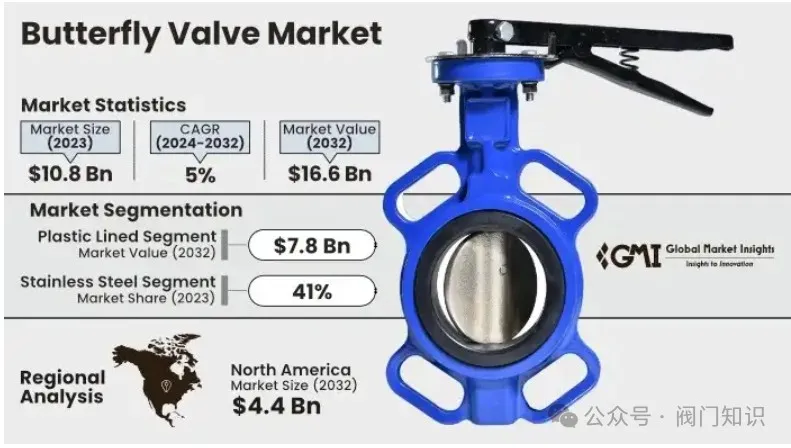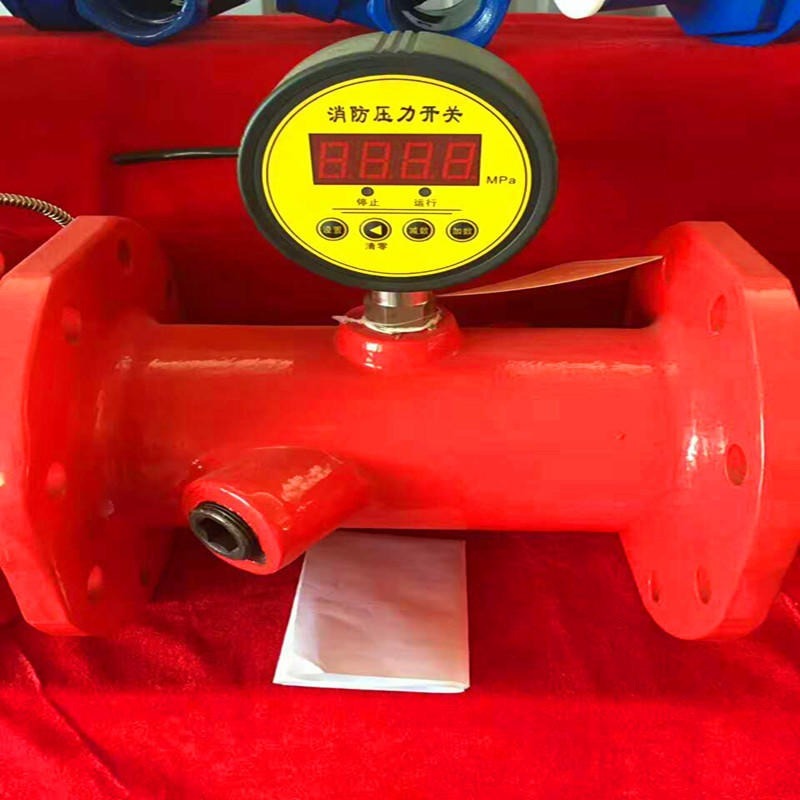The butterfly valve market was valued at $10.8 billion in 2023 and is projected to grow at a CAGR of 5% from 2024 to 2032.
2024-09-15

Butterfly Valve Market Size
In 2023, the butterfly valve market was valued at $10.8 billion, with a projected compound annual growth rate (CAGR) of 5% from 2024 to 2032. A key driver is the demand for butterfly valves in the oil and gas industry, particularly for applications requiring stainless steel valve bodies due to their high-pressure tolerance and low maintenance. These valves are used in the extraction, refining, and transportation of oil and gas.
Butterfly valves have a simple structure and a quarter-turn on/off operation, making them ideal for automated processes. This aligns with the growing automation trend across industries to improve efficiency and safety. The chemical processing industry relies on butterfly valves to regulate fluid flow in various processes. Their ease of operation and tight shut-off characteristics make them a preferred choice. Power plants utilize butterfly valves to control fluid flow due to the increasing demand for power generation from both traditional and renewable energy sources. Market Growth Opportunities
The market is fragmented, with numerous players. This can lead to intense competition and price pressure, especially for standard butterfly valve products. While butterfly valves generally offer good shut-off capabilities, wear and tear over time can lead to potential leakage issues. Regular maintenance and potential replacement of worn parts are crucial to ensure continued leak-free operation.
Butterfly Valve Market Trends
Manufacturers are exploring materials such as nickel alloys and specialty metals to create butterfly valves capable of withstanding extreme temperatures, harsh chemicals, and abrasive fluids. This caters to the demands of industries such as oil and gas exploration and chemical processing. The use of composite materials such as reinforced nylon and fiberglass offers a lighter-weight alternative to traditional metal valves. This is beneficial for applications where weight reduction or corrosion resistance is required. Butterfly valves are increasingly equipped with automation features such as electric or pneumatic actuators. This allows for remote control and integration with industrial automation systems, improving process efficiency and safety.
The emergence of smart butterfly valves with embedded sensors and diagnostic capabilities is gaining traction. These valves can provide real-time data on performance parameters such as flow rate, pressure, and valve position. This data can be used for predictive maintenance, optimized operation, and preventing downtime.
Butterfly Valve Market Analysis
By liner type, the plastic-lined segment was valued at over $4.9 billion in 2023 and is projected to exceed $7.8 billion by 2032. Plastic liners, such as PTFE (polytetrafluoroethylene) or PFA, exhibit excellent resistance to a wide range of corrosive chemicals, making them suitable for highly corrosive environments (chemical processing, pharmaceutical industries). Plastic liners offer a low coefficient of friction, reducing pressure drop, and are ideal for viscous fluids or applications requiring minimal product contamination (food and beverage processing). Plastic liners are lighter than metal alternatives, making them a cost-effective choice for applications where weight reduction is advantageous (aerospace, marine).
In 2023, by material, the stainless steel market held a dominant market share of around 41%. Stainless steel offers excellent corrosion resistance, making it highly suitable for applications involving harsh chemicals, saltwater, or high-humidity environments (chemical processing, marine applications). Stainless steel provides a good balance of strength, corrosion resistance, and cost-effectiveness, making it a versatile choice for various applications. In 2023, the North American butterfly valve market size exceeded $2.8 billion and is projected to reach $4.4 billion by 2032. North America is a significant producer and consumer of oil and gas. This translates to high demand for butterfly valves, especially stainless steel variants, throughout the oil and gas value chain (extraction, refining, transportation). Their ease of operation and reliable shut-off are crucial in these processes. The US market is expected to witness a CAGR of 5.4% by 2032. US power generation facilities are increasingly relying on butterfly valves due to their simple design, tight shut-off capabilities, and potential for automation to optimize energy production processes. The German butterfly valve market maintains a considerable position in Europe. The EU enforces stringent environmental regulations. Butterfly valves with features such as minimal leakage and energy efficiency are increasingly sought after to comply with these regulations and contribute to sustainability goals.
China is projected to grow at the highest rate in the region at 6.1%. China's rapid urbanization translates to a surge in high-rise buildings and modern infrastructure projects. This creates significant demand for butterfly valves in water distribution systems, wastewater treatment plants, and HVAC systems within buildings. The butterfly valve industry appears to be consolidated in nature due to the presence of local and global players across the globe. These prominent players are actively involved in strategic endeavors such as mergers and acquisitions, facility expansions, and collaborations to expand their product portfolio, broaden their reach, expand their customer base, and solidify their market position.
Next:
Contact Us
Email:
Tel/WeChat:
Address:
Chenggong Development Zone, Ximei Street, Nan'an City, Quanzhou City, Fujian Province









